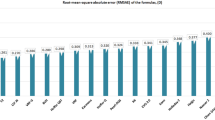Abstract
Purpose
Our purpose was to determine the effect of fluid-air exchange on the amount of silicone oil (SO) droplets remaining in the vitreous cavity after removal of the main body of the SO.
Methods
This was a retrospective comparative study of 56 eyes of 56 patients that had undergone vitrectomy with SO tamponade. Fluid-air exchange was performed during surgery in 30 eyes [Air Ex(+) group] and was not done in 26 eyes [Air Ex(−) group]. All of the eyes were examined by ultrasonography, and the images were converted to binarized image. The amount of residual SO droplets/vitreal area in the images was expressed as the, “silicone oil index (SOI)”. The correlations between SOI and clinical findings were determined.
Results
The SOI was significantly correlated with the axial length (AL, R = 0.444, P = 0.023). The SOI in the Air Ex(+) group was significantly higher (7.4 ± 2.6%) than in the Air Ex(−) group (4.9 ± 3.4%; P = 0.004). Multiple linear regression analyses showed that the SOI was independently and significantly correlated with the AL and the Air Ex(+) group (P = 0.003, P = 0.006, respectively).
Conclusions
Fluid-air exchange during vitrectomy to remove residual SO is not effective. Our findings indicate that it may increase the amount of residual SO droplets.





Similar content being viewed by others
References
Cibis PA, Becker B, Okun E, Canaan S (1962) The use of liquid silicone in retinal detachment surgery. Arch Ophthalmol 68:590–599
Federman JL, Schubert HD (1988) Complications associated with the use of silicone oil in 150 eyes after retina-vitreous surgery. Ophthalmology 95:870–876
Franks WA, Leaver PK (1991) Removal of silicone oil--rewards and penalties. Eye 5(Pt 3):333–337. doi:10.1038/eye.1991.53
Lucke KH, Foerster MH, Laqua H (1987) Long-term results of vitrectomy and silicone oil in 500 cases of complicated retinal detachments. Am J Ophthalmol 104:624–633
Riedel KG, Gabel VP, Neubauer L, Kampik A, Lund OE (1990) Intravitreal silicone oil injection: complications and treatment of 415 consecutive patients. Graefe’s archive for clinical and experimental ophthalmology = Albrecht von Graefes Archiv fur klinische und experimentelle. Ophthalmologie 228:19–23
Oh HJ, Chang W, Sagong M (2015) Efficacy and safety of active silicone oil removal through a 23-gauge transconjunctival cannula using an external vacuum pump. Int J Ophthalmol 8:347–352. doi:10.3980/j.issn.2222-3959.2015.02.24
Zhang Z, Wei Y, Jiang X, Qiu S, Zhang S (2015) A machine-independent method to have active removal of 5,000 centistokes silicone oil using plastic infusion tube and 23-gauge microcannulas. BMC Ophthalmol 15:114. doi:10.1186/s12886-015-0103-2
Budenz DL, Taba KE, Feuer WJ, Eliezer R, Cousins S, Henderer J, Flynn HW Jr (2001) Surgical management of secondary glaucoma after pars plana vitrectomy and silicone oil injection for complex retinal detachment. Ophthalmology 108:1628–1632
Kampik A, Gandorfer A (2000) Silicone oil removal strategies. Semin Ophthalmol 15:88–91. doi:10.3109/08820530009039998
Oliveira LB, Reis PA (2007) Silicone oil tamponade in 23-gauge transconjunctival sutureless vitrectomy. Retina 27:1054–1058. doi:10.1097/IAE.0b013e318113235e
Patwardhan SD, Azad R, Shah V, Sharma Y (2010) The safety and efficacy of passive removal of silicone oil with 23-gauge transconjunctival sutureless system. Retina 30:1237–1241. doi:10.1097/IAE.0b013e3181dde612
Henneken A, Machemer R (1991) Ultrasonographic ‘oil droplet phenomenon’. Arch Ophthalmol 109:320
Spaide RF, Chung JE, Fisher YL (2005) Ultrasound detection of silicone oil after its removal in retinal reattachment surgery. Retina 25:943–945
Shiihara H, Terasaki H, Yoshihara N, Shirasawa M, Otsuka H, Yamashita T, Yamakiri K, Sonoda S, Sakamoto T (2016) Amount of residual silicone oil in vitreous cavity is significantly correlated with axial length. Retina 36:181–187. doi:10.1097/IAE.0000000000000656
Kunimoto DY, Kaiser RS, Wills Eye Retina S (2007) Incidence of endophthalmitis after 20- and 25-gauge vitrectomy. Ophthalmology 114:2133–2137. doi:10.1016/j.ophtha.2007.08.009
Sonoda S, Sakamoto T, Yamashita T, Shirasawa M, Uchino E, Terasaki H, Tomita M (2014) Choroidal structure in normal eyes and after photodynamic therapy determined by binarization of optical coherence tomographic images. Invest Ophthalmol Vis Sci 55:3893–3899. doi:10.1167/iovs.14-14447
Agrawal R, Gupta P, Tan KA, Cheung CM, Wong TY, Cheng CY (2016) Choroidal vascularity index as a measure of vascular status of the choroid: measurements in healthy eyes from a population-based study. Sci Rep 6:21090. doi:10.1038/srep21090
Uji A, Balasubramanian S, Lei J, Baghdasaryan E, Al-Sheikh M, Sadda SR (2017) Impact of multiple En face image averaging on quantitative assessment from optical coherence tomography angiography images. Ophthalmology. doi:10.1016/j.ophtha.2017.02.006
Acknowledgements
The authors thank Professor Emeritus Duco Hamasaki, of the Bascom Palmer Eye Institute of the University of Miami for providing critical discussions and suggestions to our study and revision of the final manuscript. The authors also thank Keita Yamakiri, MD, PhD, Hiroki Otsuka, MD, PhD, Tetsuo Ueda, MD, Hiroki Tsujinaka, MD, Kentaro Semba, MD, PhD, Takashi Katome, MD, PhD for their surgical contributions.
Author information
Authors and Affiliations
Corresponding author
Ethics declarations
The procedures used in this study were approved by the Institutional Review Board of Kagoshima University Hospital, and the procedures conformed to the tenets of the 1989 Declaration of Helsinki.
Informed consent
Informed consent was obtained from all individual participants included in the study.
Funding
The funding organizations had no role in the design or conduct of this research. This study was in part supported by JSPS Grant-in-Aid for Scientific Research.
Conflict of interest
The authors certify that they have no affiliations with or involvement in any organization or entity with any financial interest or non-financial interest in the subject matter or materials discussed in this manuscript.
Rights and permissions
About this article
Cite this article
Shiihara, H., Sakamoto, T., Terasaki, H. et al. Effect of fluid-air exchange on reducing residual silicone oil after silicone oil removal. Graefes Arch Clin Exp Ophthalmol 255, 1697–1704 (2017). https://doi.org/10.1007/s00417-017-3701-2
Received:
Revised:
Accepted:
Published:
Issue Date:
DOI: https://doi.org/10.1007/s00417-017-3701-2




